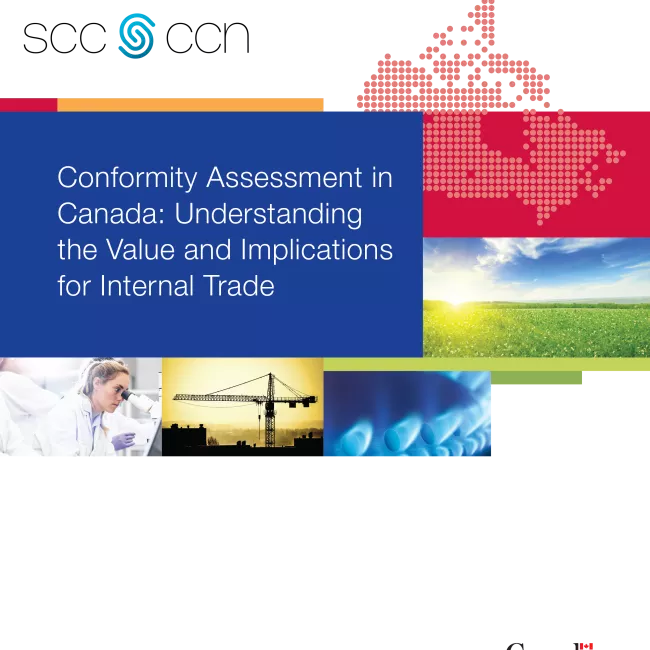SCC is committed to supporting internal trade in Canada by embracing emerging challenges and opportunities. We are actively working to enhance Canada’s domestic trade resilience by strengthening key areas such as supply chain resilience and traceability and labour mobility.
Advancing free trade within Canada
SCC works with industry representatives and regulators at all levels to build consensus and implement consistent accreditation and conformity assessment requirements across the country. This strengthens Canada’s internal market.
We support the implementation of the Canadian Free Trade Agreement to enable the free movement of persons, goods, services and investments across borders within Canada and safeguard an open and stable domestic market.
Enhancing safety, certification, and workforce mobility
When provinces and territories have different requirements, this can create trade barriers for products, services and professionals.

Trade barrier
A crane operator trained in one province or territory may not be qualified to work in another.
Standardization solution
Crane Operator Certification Program – In collaboration with WorkSafe BC, SCC introduced an ISO/IEC 17024-accredited certification program, ensuring crane operator credentials are universally recognized across provinces without additional qualifications.

Trade barrier
A product, such as pressure vessels like boilers, that needs to comply to different standards, or be re-certified to the same standard, in different provinces and territories. For boilers, a Canadian Registration Number must be issued by each province or territory it is used in.
Standardization solution
To eliminate duplication, a design review (required to obtain the registration number) is mutually accepted in provinces and territories who have signed on to the reconciliation agreement. This protects public safety while removing barriers and reducing costs from multiple provincial/territorial applications and design reviews.
Free trade within Canada
Sometimes, different requirements and regulations are needed. But other times, they cause barriers to trade that create red tape for businesses without tangible benefits.
By helping to align regulations across the country, we
- support free trade in Canada by removing unnecessary trade barriers
- make Canadian companies more competitive
- increase opportunities for Canadian workers
- provide better prices and more choice for Canadians
Our role
We help to break down internal trade barriers by working to align standards in federal, provincial and territorial regulations.
This will help:
- move us toward freer trade in Canada
- result in a healthier, more sustainable and competitive nation in the years ahead
- result in lower costs for Canadian consumers
Through the Provincial and Territorial Advisory Committee (PTAC), we work with governments across Canada as they identify and prioritize sectors where aligning standards can benefit Canadians. More about PTAC’s impact.
We collaborate with Regulatory Authority Advisory Bodies (RAABs), which include federal, provincial, and territorial public safety and energy efficiency regulators. We offer expert guidance to promote harmonization, ensuring a consistent and unified public safety framework. More about RAABs.
SCC’s Accreditation Programs
SCC’s accreditation supports consistent certification of products, processes, and services across Canada
Canadian regulators at federal and provincial levels have embraced the value of third-party certification as part of their oversight to ensure the safety and performance of various products, including those in the electric, plumbing, gas and construction sectors, among others.
SCC oversees eleven accreditation programs and over forty-five schemes. These accreditation and conformity assessment programs include management systems certification, laboratory testing, and product certification.
Certification Body Accreditation Program
SCC is Canada’s only internationally recognized accreditation body offering the Certification Body Accreditation Program (CBAP), based on ISO/IEC 17065, ensuring consistent certification of products, processes, and services across Canada.
The Certification Body Accreditation Program - Requirements and Guidance document, developed through consensus among regulators, harmonizes certification requirements, reducing regulatory fragmentation and facilitating internal trade across provinces.
Inspection Body Accreditation Program
Like the CBAP, SCC is the only accreditation body in Canada offering the Inspection Body Accreditation Program (IBAP), which is based on ISO/IEC 17020, the international standard for the operation of various types of inspection bodies.
To harmonize inspection practices, SCC developed the IBAP-Requirements and Guidance document through consensus among federal, provincial, and territorial regulators, ensuring a uniform approach to inspections and compliance across Canada. This alignment facilitates internal trade and enhances trade mobility.
Research

Conformity Assessment in Canada: Understanding the Value and Implications for Internal Trade
This report provides a broad overview of the conformity assessment system, what it is, how it operates, its social and economic importance to Canada, and the implications for internal trade.